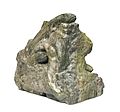Albert Power (sculptor) facts for kids
Quick facts for kids
Albert Power
|
|
|---|---|
| Born |
Albert George Power
16 November 1881 Dublin, Ireland
|
| Died | 10 July 1945 (aged 63) Dublin
|
| Nationality | Irish |
| Occupation | Sculptor |
Albert George Power (born November 16, 1881 – died July 10, 1945) was a famous Irish sculptor. He created art in a realistic style, making things look very true to life. He is especially well-known for his famous statue of the Irish writer Pádraic Ó Conaire.
Contents
Early Life and Family
Albert George Power was born in Dublin, Ireland, on November 16, 1881. His parents were Mary, who was an embroiderer, and Henry, a watchmaker. Albert had an older brother and a younger sister.
He went to a Christian Brothers school. As a child, he loved playing in local clay brickyards. He even sculpted small busts (head and shoulders statues) of his friends.
After primary school, Albert trained with a company of sculptors led by Edward Smyth. In 1884, he started evening classes at the Dublin Metropolitan School of Art. Later, from 1906 to 1911, he became a full-time student there. His teachers, like John Hughes, Oliver Sheppard, and William Orpen, greatly influenced his art.
In 1903, Power married Agnes Kelly. They had a large family with ten children – four daughters and six sons. Two of their children, May and James, also became talented sculptors.
Albert Power's Career as a Sculptor
In 1912, Albert Power started his own stone-carving business. He worked from his new home in Phibsborough, Dublin. As his business grew, he moved it to a bigger place nearby in 1930.
Power created many different types of artworks. These included large monuments and detailed architectural features. He worked with bronze, marble, and stone. Some of his famous architectural pieces include:
- The figure of "Science" on the front of the new Royal College of Science building in Dublin.
- Carved designs and sphinx statues for the Gresham Hotel on O'Connell Street.
- Four statues on the dome of Christ the King church in Carndonagh.
Leading Irish Sculptor
Albert Power was considered the most important Irish sculptor in the 1920s and 1930s. He was a nationalist, meaning he supported Ireland's independence. He also encouraged using Irish materials, such as limestone from Durrow and Connemara marble.
He was known for his academic realist style. This meant his sculptures looked very lifelike and followed traditional art rules. He regularly showed his work at the Royal Hibernian Academy. He became an associate member in 1911 and a full member in 1919.
Famous People He Sculpted
Power created sculptures of many well-known people. These included:
- Writer James Stephens (1913)
- Poet W. B. Yeats (1918)
- Writer Lord Dunsany (1920)
One of his supporters was Oliver St. John Gogarty. Through Gogarty, Power was asked to sculpt many important Irish nationalists. For example, Gogarty asked Power to create a portrait of Terence MacSwiney in 1920. MacSwiney was in prison at the time. Power was allowed to make a quick sketch in the prison. From this sketch, he carved a special portrait called a "life mask."
The government of the Irish Free State also asked Power to create portraits of important politicians. These included Arthur Griffith (1922), Michael Collins (1936), and Austin Stack (1939). He also made a private portrait of Éamon de Valera in 1944.
Monumental Works
Among his large public sculptures are:
- A statue of Tom Kettle (1919) in St Stephen's Green, Dublin.
- The famous statue of Pádraic Ó Conaire (1935) in Eyre Square, Galway.
- A sculpture of W. B. Yeats (1939) in Sandymount Green, Dublin.
In 1928, Albert Power was one of the artists asked to design the new coins for the Irish Free State.
Death
Albert Power passed away on July 10, 1945. He was buried in Glasnevin Cemetery in Dublin.
Works
-
Bust of W. B. Yeats by Power (1918)
Displayed in the Harry Ransom Center, University of Texas at Austin, USA. -
1916 memorial designed by Power
Erected in Limerick, Ireland -
Connemara Trout (1944) by Power, now held in the National Gallery of Ireland




